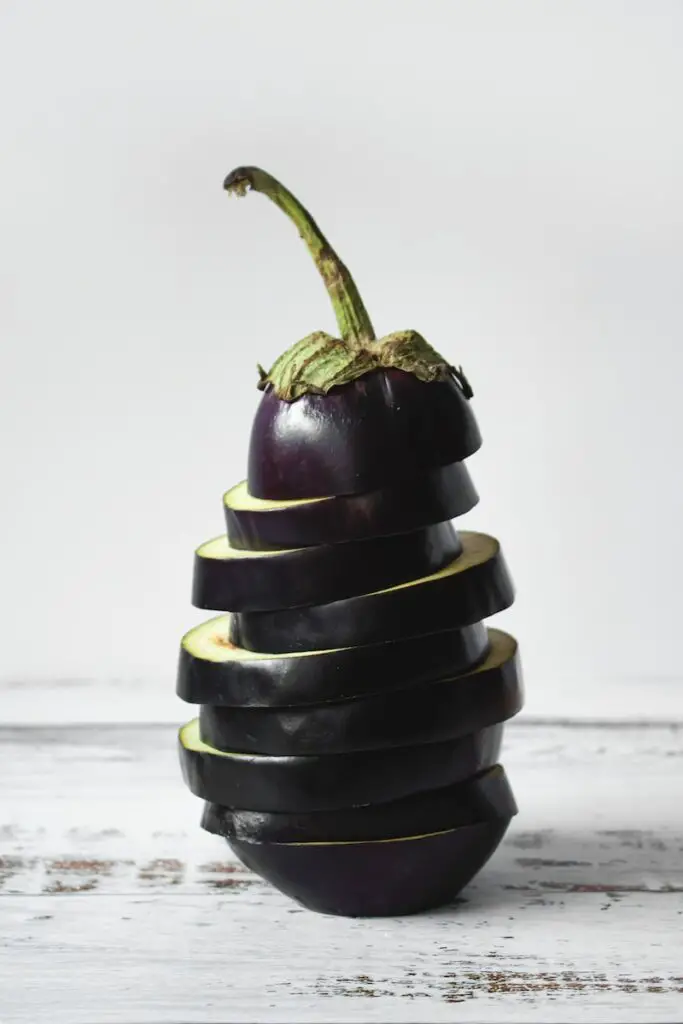
When it comes to cooking with eggplants, it’s important to know how to tell if they are still good to use. An eggplant that has gone bad can ruin a dish and even make you sick. In this article, you will learn how to identify the signs of a bad eggplant and how to properly store them to extend their shelf life.
One of the first signs that an eggplant is going bad is its appearance. A fresh eggplant should have a smooth and shiny surface with a deep purple color. If you notice any discoloration or bruising on the skin, it may be an indication that the eggplant is no longer fresh. Additionally, a bad eggplant may have a soft or mushy texture, which is a sign that it has started to rot.
To ensure that your eggplants stay fresh for as long as possible, it’s important to store them properly. Eggplants should be kept in a cool and dry place, away from direct sunlight. They should also be stored separately from other fruits and vegetables, as they can release ethylene gas that can cause them to ripen and spoil more quickly. By following these tips, you can ensure that your eggplants stay fresh and delicious for your next culinary creation.
Table of Contents
Identifying Bad Eggplant

When it comes to selecting eggplants, it can be challenging to determine whether they are fresh or not. However, there are several signs that can help you identify bad eggplants. Here are some of the key things to look out for:
Color
Eggplants come in various shades of purple, ranging from deep purple to almost black. A fresh eggplant should have a glossy, taut skin with no discoloration or bruises. On the other hand, a bad eggplant may have a brownish color, indicating that it is overripe or has started to spoil.
Texture
A fresh eggplant should have a firm, smooth texture with no soft or squishy spots. If an eggplant feels rubbery or slimy to the touch, it may be a sign that it has gone bad. Additionally, if you notice any cracks or wrinkles on the skin, it could also be an indication that the eggplant is past its prime.
Smell
A fresh eggplant should have a mild, earthy aroma. If the eggplant has a sour or rotten odor, it is a clear sign that it has gone bad.
Appearance
When selecting an eggplant, it is essential to examine the overall appearance of the vegetable. A fresh eggplant should be heavy for its size, indicating that it is ripe and ready to eat. However, if the eggplant feels light or hollow, it may be a sign that it is not fresh.
Stem
The stem of an eggplant can also provide clues about its freshness. A fresh eggplant should have a green stem that is firmly attached to the vegetable. If the stem is brown or withered, it could be a sign that the eggplant is overripe or has started to spoil.
Interior
When you cut into an eggplant, the flesh should be white and firm. If the flesh is discolored or has dark spots, it may be a sign that the eggplant is not fresh. Additionally, if the flesh has a slimy texture, it is a clear indication that the eggplant has gone bad.
Weight
As mentioned earlier, a fresh eggplant should be heavy for its size. If the eggplant feels light or airy, it could be a sign that it has started to dry out or spoil.
Blemishes and Brown Spots
A fresh eggplant should have a smooth, unblemished skin with no brown spots or bruises. If you notice any blemishes or brown spots on the skin, it may be a sign that the eggplant is not fresh.
Enzymatic Browning
If you cut into an eggplant and notice that the flesh has turned brown, it is a clear indication that the vegetable has started to oxidize and is no longer fresh. To prevent enzymatic browning, you can sprinkle lemon juice on the cut surface of the eggplant.
By keeping an eye out for these signs, you can ensure that you only select fresh, high-quality eggplants for your recipes.
Proper Storage of Eggplants

When it comes to storing eggplants, it’s essential to do it properly to ensure that they stay fresh and safe to eat for as long as possible. Here are the three best ways to store eggplants:
At Room Temperature
Eggplants can be stored at room temperature, but they should be used within a few days. If you’re going to store an eggplant at room temperature, make sure it’s in a cool, dry place away from direct sunlight. Keep in mind that eggplants can quickly become overripe and spoil, so check them regularly for any signs of spoilage.
In the Refrigerator
If you’re not planning on using your eggplants right away, it’s best to store them in the refrigerator. When storing eggplants in the fridge, make sure they’re in a plastic bag or container to prevent moisture loss. Eggplants can last up to a week in the refrigerator if stored properly.
In the Freezer
If you have too many eggplants and can’t use them all before they spoil, you can freeze them. To freeze eggplants, first, wash and slice them into desired sizes. Then, blanch them in boiling water for 4-5 minutes and let them cool. Finally, place the eggplant slices in a freezer-safe container or bag and store them in the freezer for up to 6 months.
When it comes to storing eggplants, it’s essential to keep in mind their shelf life and how they should be stored to prevent spoilage. By following the proper storage methods, you can ensure that your eggplants stay fresh and safe to eat for as long as possible.
Frequently Asked Questions
When it comes to eggplants, there are several questions that people often ask to determine if an eggplant is bad or not. Here are some frequently asked questions and their answers:
Q: How to tell if an eggplant is bad?
A: There are several signs of bad eggplant that you can look for. First, check the skin for any discoloration or spots. If the eggplant has a brown or black spot, it is likely bad. Additionally, if the eggplant has a soft texture or feels squishy, it is also a sign that it is no longer good.
Q: How can you tell if an eggplant is good?
A: A good eggplant should have a fresh-looking, smooth, and shiny skin. It should also feel firm to the touch, with no soft spots or bruises.
Q: Can you still use an eggplant if it’s a little soft?
A: If the eggplant is only slightly soft, it may still be okay to use. However, if it is mushy or has a squishy texture, it is best to discard it.
Q: What are some other signs of bad eggplant?
A: In addition to discoloration, soft texture, and squishiness, bad eggplant may also have a foul odor or mold growing on it. If you notice any of these signs, it is best to throw the eggplant away.
Q: How long does eggplant last in the fridge?
A: Eggplant can last for up to a week in the fridge if stored properly. To keep it fresh, store it in a plastic bag in the vegetable crisper drawer of your fridge.
By keeping these frequently asked questions in mind, you can easily tell if an eggplant is bad and avoid using it in your cooking.
Conclusion
In conclusion, it is important to know how to tell if an eggplant is bad in order to avoid any potential health risks and to ensure that your recipes turn out as intended. When shopping for eggplants, look for ones that are firm and have a shiny, smooth skin. If the skin is wrinkled or has indentations, it may be a sign that the eggplant is overripe or has been stored improperly.
When preparing eggplants, it is important to cut off the stem and check the cap for any signs of mold or discoloration. If the cap is white and the eggplant has a fresh aroma, it is likely in good condition. However, if the cap is brown or withered, it may be a sign that the eggplant is past its prime.
It is also important to note that eggplants are part of the nightshade family and may not be suitable for everyone, especially those with sensitivities to this group of vegetables. When cooking eggplants, there are many healthy options such as baking or frying, but it is important to be mindful of added fats and oils.
Overall, by following these tips and paying attention to the condition and appearance of your eggplants, you can ensure that your meals are both delicious and safe to eat.